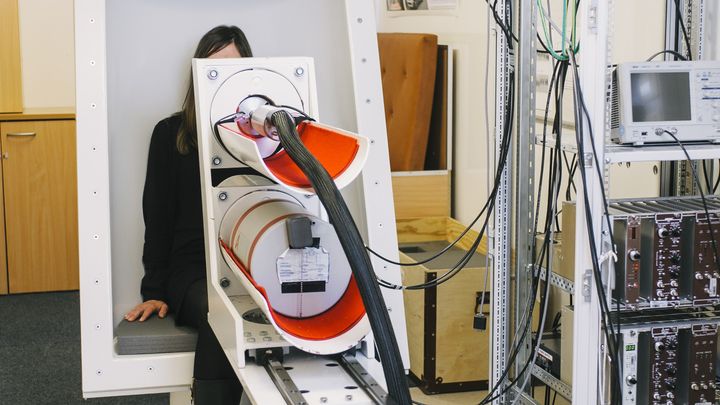Radiation and Nuclear Safety Authority measures human radioactivity in Rovaniemi
Human radioactivity measurements to be carried out by the Radiation and Nuclear Safety Authority in Rovaniemi are part of the programme to measure the radioactivity of the population, which began in the 1960s.

The box truck parked in front of the main door of the Rovaniemi campus of the University of Lapland from Monday, 8 April to Thursday, 11 April, will reveal what radioactive substances are in the human body and how much radiation the human body emits.
Volunteer students and staff from the University of Lapland and the Lapland University of Applied Sciences have been invited to participate in the measurements that will take fifteen minutes.
STUK also carries out similar measurements in Helsinki and Tampere. On the basis of the measurements, STUK calculates the radiation doses that Finns receive from radioactive substances in themselves and how much of the substances and doses comes from man-made substances.
Reindeer breeders were measured first
The first group called to population measurements in Finland were reindeer breeders in Northern Lapland, and the first measurements were carried out in 1962. At that time, radioactive materials from nuclear weapons detonated in the atmosphere landed along with the rains, especially in the north. Lichens effectively collected radioactivity and, through reindeer, it accumulated especially in reindeer breeders who ate a lot of reindeer meat.
Nuclear weapons tests have not been carried out in the atmosphere in the north since 1963, and the last nuclear weapon explosion in the atmosphere in general dates back to 1980. Today, the radioactivity of reindeer breeders is no different from that of the rest of the population. This is also influenced by the diversification of reindeer breeders’ diets.
However, there are still very small but measurable amounts of radioactive substances in Finnish nature, both from nuclear weapons tests and from the Chernobyl accident of 1986. Of these, the most significant is the caesium isotope 137.
There is no need to worry about the radiation dose caused by caesium-137. It is less than one-thousandth of the total annual average dose received by Finns from various sources and has no impact on human health.
Most of the radiation dose received by Finns is due to various external sources, and not the radioactivity inside the body. Indoor radon gas in homes and workplaces causes most of the radiation received by Finns.
Keywords
Contacts
Media contacts
Tel:+358(10)8504761Subscribe to releases from Säteilyturvakeskus (STUK)
Subscribe to all the latest releases from Säteilyturvakeskus (STUK) by registering your e-mail address below. You can unsubscribe at any time.
Latest releases from Säteilyturvakeskus (STUK)
Melanom fortsätter att bli vanligare i Finland – i synnerhet unga upplever inte solen som en hälsorisk23.4.2024 09:30:00 EEST | Tiedote
Med tillräckligt skydd mot solens UV-strålning skulle man kunna förhindra fyra av fem fall av melanom. Men inte ens god kunskap om solens hälsorisker kan garantera tillräckligt skydd. Särskilt för unga kan det vara svårt att beakta långsiktiga hälsorisker.
Melanooma jatkaa yleistymistä Suomessa – etenkään nuoret eivät koe aurinkoa terveysriskinä23.4.2024 09:30:00 EEST | Tiedote
Riittävällä suojautumisella auringon UV-säteilyltä pystyttäisiin ehkäisemään neljä viidestä melanoomatapauksesta. Hyvätkään tiedot auringon terveyshaitoista eivät kuitenkaan takaa riittävää suojautumista. Etenkin nuorten voi olla vaikeaa huomioida pitkän aikavälin terveysriskiä.
Melanoma continues to become more common in Finland – young people in particular do not consider the sun to be a health risk23.4.2024 09:30:00 EEST | Press release
Adequate protection from the sun's UV radiation would prevent four out of five cases of melanoma. However, even good information about the health hazards of the sun does not guarantee adequate protection. Young people in particular may find it difficult to take long-term health risks into account.
Kutsu Ilmatieteen laitoksen, Syöpäjärjestöjen ja Säteilyturvakeskuksen tiedotustilaisuuteen UV-säteilystä16.4.2024 07:16:51 EEST | Kutsu
Ihon suojaamiseen auringon UV-säteilyltä kannattaa jo kiinnittää huomiota. UV-indeksi saattaa kevätauringossa kivuta jo kolmeen tai sen yli. Tällöin on syytä suojautua. Ilmatieteen laitos, Syöpäjärjestöt ja Säteilyturvakeskus kutsuvat median edustajia kuulemaan tietoa auringon UV-säteilystä aamiaistilaisuuteen tiistaina 23. huhtikuuta.
Strålsäkerhetscentralen mäter radioaktivitet hos människor i Rovaniemi4.4.2024 08:00:00 EEST | Tiedote
Strålsäkerhetscentralens mätningar av radioaktivitet hos människor i Rovaniemi är en del av det program för mätning av radioaktivitet hos befolkningen som inleddes redan på 1960-talet.
In our pressroom you can read all our latest releases, find our press contacts, images, documents and other relevant information about us.
Visit our pressroom